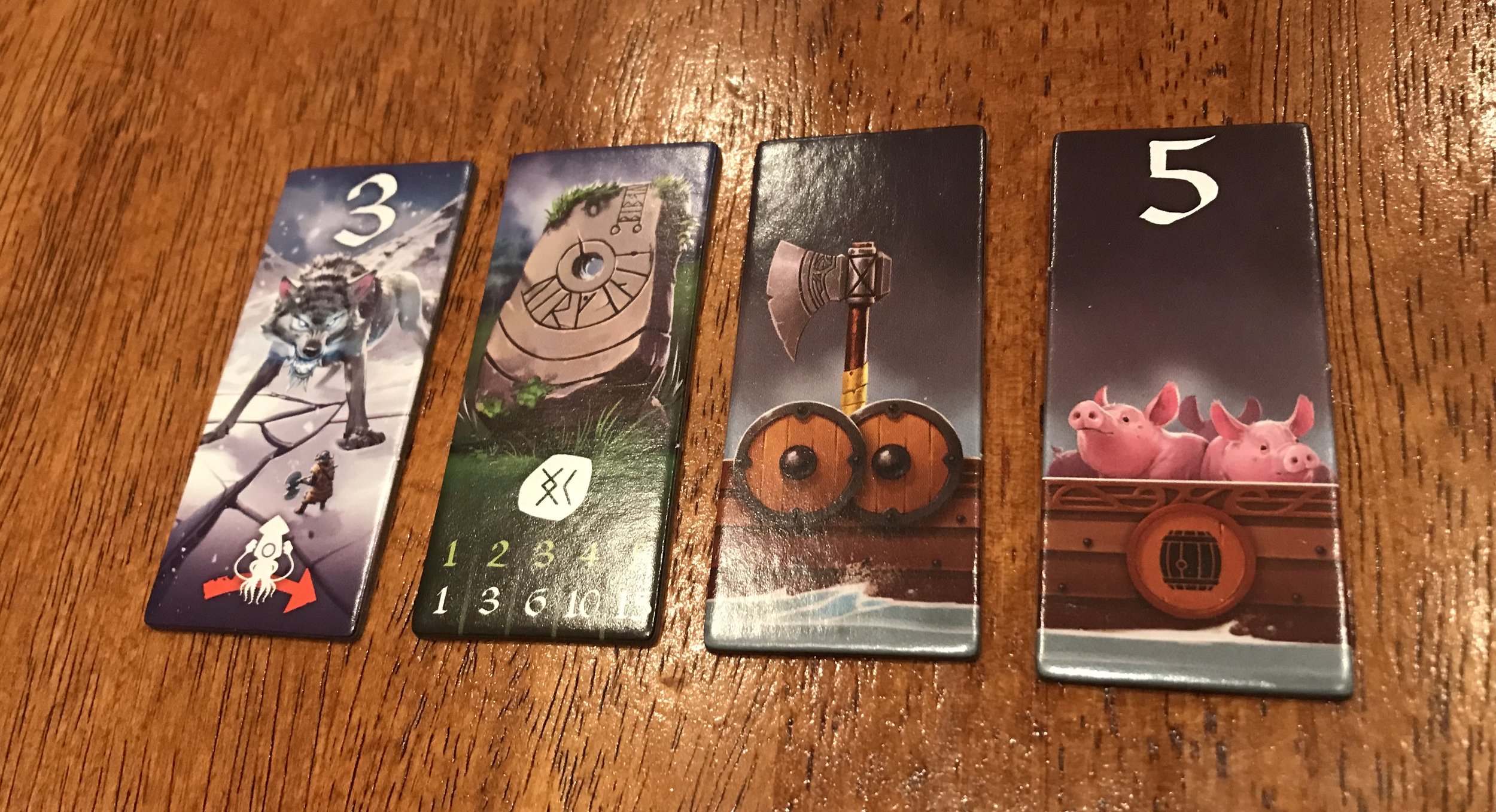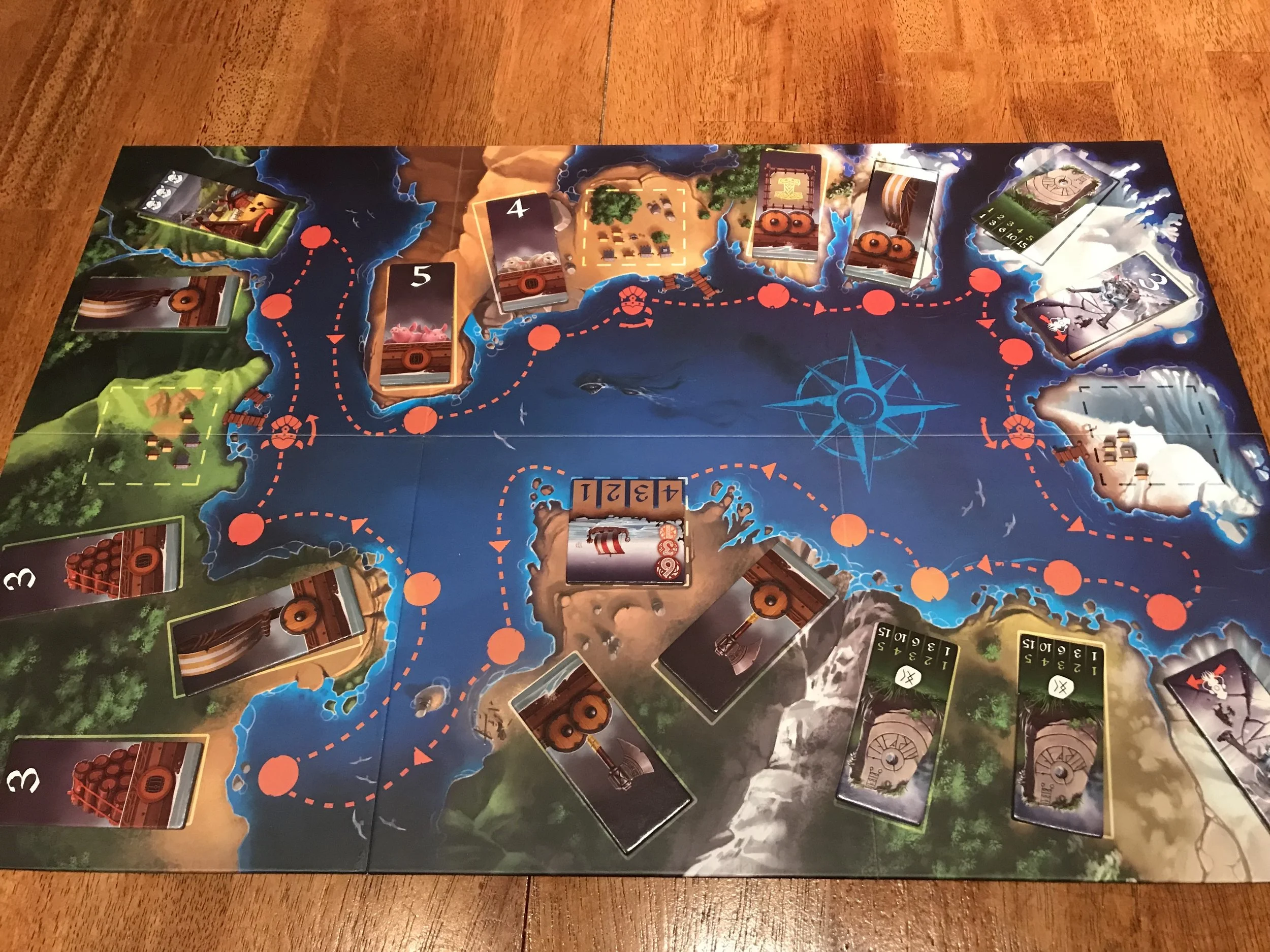The Longship and the Short of It--A Double-Take Review of Raids
/There are a number of themes that seem to crop up over the years. Zombies. Pirates. And lately it’s been Vikings! In today's review we’re taking a look at Raids, the latest from Iello Games. As viking captains, players will be voyaging from village to village, pillaging and plundering—and battling each other over these rewards!
So is Raids a pleasure cruise? Or is it headed for an iceberg? Let’s find out!
The Components
The components are mainly cards.
4 Longships - One for each player.
40 Viking meeples - You’ll need these to fight your opponents.
20 Coins - The Coins are victory points, they call them “Glory Points” in this game.
4 Longship boards - There are 5 slots on each board. You can place 1 tile on each of those slots.
The game board - It’s…the board.
9 Harbor tiles - these randomly give points out for the end of each Voyage.
64 Voyage tiles - Some of these will go onto your ship to modify it. Others you collect next to your board. And some are monsters that you’ll have to defeat. These are separated into 4 sets based on the number on their backs—one set for each voyage.
The Setup
Setup is fairly easy. You place the board on the table, and place the Viking meeples and coins in piles to make a supply. Each player chooses a color of Longship marker as well as a matching Longship board. Each player will get a certain amount of Viking meeples depending on their starting position. Then you’ll populate the board with the first set of Voyage tiles, and that’s pretty much it. Place a Harbor tile in the harbor spot, and you’re ready to go!
The Gameplay
You’ll be taking four Voyages over the course of the game. Each Voyage has two phases
Take a voyage tile. At the start of your turn, you’ll take whatever Voyage tile you happen to be in front of. (You won’t do this on your first turn, because there’s no tile you can take.) Weapons, Sails, Mjollnirs (VPs), Pennants, and Goods go directly onto your Longship. Runes, Monsters, and Ports go next to your Longship board. And Visit and Pillage tiles stay on the board.
Navigate your ship-- Once you’ve taken the tile you’ll move your Longship marker, following a few rules. First, you have to remove all of the tiles between you and the next closest Longship, Then you just move to a spot you want to visit next (of course there has to be a tile there…). You can even move all the way around the board and to the Harbor if you can “pay” for any tiles you encounter along the way.
You can only have as many Vikings on your ship as there are Shields on it, so some tiles will give you combat bonuses, or will give you Goods you can sell at a Market tile for money (which is VPs) but those can affect your ability to defend yourself or attack, because you’ll have fewer Vikings!
Speaking of attacking, let’s talk about that. If you choose to land on the same spot as another Longship, it’s time to battle them! You could do this because you want to get the tile they’re waiting to get at the beginning of their next turn. Or maybe you just want to stop them from getting it. Or maybe you’re just being a jerk… Whatever the case, here’s how you battle them.
If you’re initiating the battle (the one who stopped where someone else is already), you must send exactly 1 of your Vikings into the battle (discard it back to the supply). Your opponent most either retaliate (discard 2 Vikings) or flee (sail ahead to any other tile). If they retaliate, you must choose to retaliate (this time for 3 Vikings, and so on) or flee. If someone flees they can initiate another battle if they have at least one Viking to throw into the fray.
You also need Vikings for defeating Monsters. When you encounter a Monster tile, you either have to sacrifice a Viking to pass by, or you can choose to fight it by discarding Vikings equal to the Monster’s strength. Any Weapons you have on your Longship will reduce the Monster’s strength by the number of Weapons. If you defeat the Monster, you place it next to your board and will score VPs at the end of the game.
If you pass a Village, Visit, or Pillage tile, you keep moving but get the reward on it, if there are any left after other players have passed by.
Once everyone returns back the the Harbor you’ll score points based on the particular Harbor tile that’s currently in play, and then set up the next voyage with a new set of Voyage tiles and a new Harbor tile. After the fourth Voyage, tally up scores and the highest score wins!
The Verdict
Jeremiah—There is, in my opinion, a definite “feel” to a Iello game. They’re generally light, bright, and fun, with high-quality components, and are what I like to call “family weight”. And Raids is no different—trust me, that’s not a knock.
Firestone—I know what you mean. This definitely falls into the “family” category for me, too. I played this with my game group, and they liked it! But it was still a lighter and more chaotic game than they generally want to play. If it was shorter, it could be a game group filler. It’s too long for that, but it’s a good game for families and nongamers. My kids thought this was great fun.
Jeremiah—I love the look of the game. The components are great, the artwork is exactly what it should be, and the Viking meeples are awesome!
Firestone—The components are, indeed, terrific. The tiles are chunky. The board is bright and colorful. The Vikings are cool and very intricate. And metal coins automatically improve any game they’re in.
Jeremiah—For a game of this weight and learning curve there is a nice amount of tension between players as you vie for position, and battle over tiles to add to your ship. It cuts down on downtime between turns. and the tussles between players kept Raids lively!
Firestone—I’ve had fun experimenting with different strategies. In one Voyage I went from one of the first Voyage spaces all the way to the end, picking up Vikings, killing Monsters, and grabbing Coins along the way. I was hoping it would force the other players to rush to the end of the Voyage, gaining worse tiles than they otherwise would have. I’m not sure it worked as I was hoping, but it was still fun to try!
The trade-offs for tiles you put your Longships vs. the number of Vikings you can hold is good. Sometimes the choice of where to go seemed obvious, but other times it was a difficult decision. The variability of where those Voyage tiles come out will play a large part in the decision tree.
Jeremiah—I’m typically the kind of person that will attempt to avoid conflict, or battling other players, if I think I can stay under the radar and outlast everyone else. But Raids makes is easy and advantageous to try and pick off other players to score the sweet tiles on the board. All while adding excitement and fun to the game, not just more tedious downtime.
Firestone—Yeah, I’m usually not a big fan of aggressive games, but the aggression here feels much more subdued than in other games, even though there’s plenty of it. And it’s interesting because you can see exactly how many Vikings a player has, so you know if you attack that person at that tile, he can’t retaliate and will have to flee. But then you’re vulnerable to the players behind you. It’s a fun tension.
If there’s one downside, it’s that I’m afraid this will get old sooner rather than later. That’s because you use every Voyage tile in every game. If they’d included a few extra of each of the four sets of Voyage tiles, and then you played with a random subset of them each game, I think that would improve the replay value. As it is, there are no surprises in the game, other than where the tiles happen to land each game.
Now, this might not be a big deal for a game of this weight, so that might just be me trying to figure out ways to make this appeal to gamers more. But that’s a small complaint, and one that’s easily fixed with an expansion.
The Final Verdict
Jeremiah—Raids is exactly what I expected from Iello Games. And that’s a good thing! It’s fun, it moves, there’s little to no downtime, and it plays great with families and friends. Certain gamer types might find it a little too lightweight, but all in all this is a very accessible and fun game!
Firestone—Raids is a good, lightweight game that’s perfect for families or as a gateway game. The high production values only help elevate this. If you don’t mind a little chaos and aggression, then set sail for the high seas of Raids.
You can listen to episode 94 of That's How I Roll to hear more of Jeremiah's thoughts on Raids right here!
Thanks so much for reading! Have you played Raidsl? We'd love to hear your thoughts on it. Just comment below or email us by clicking the contact button up top!
We'd like to thank Iello Games for providing review copies of Raids; this in no way influenced our opinions.



















